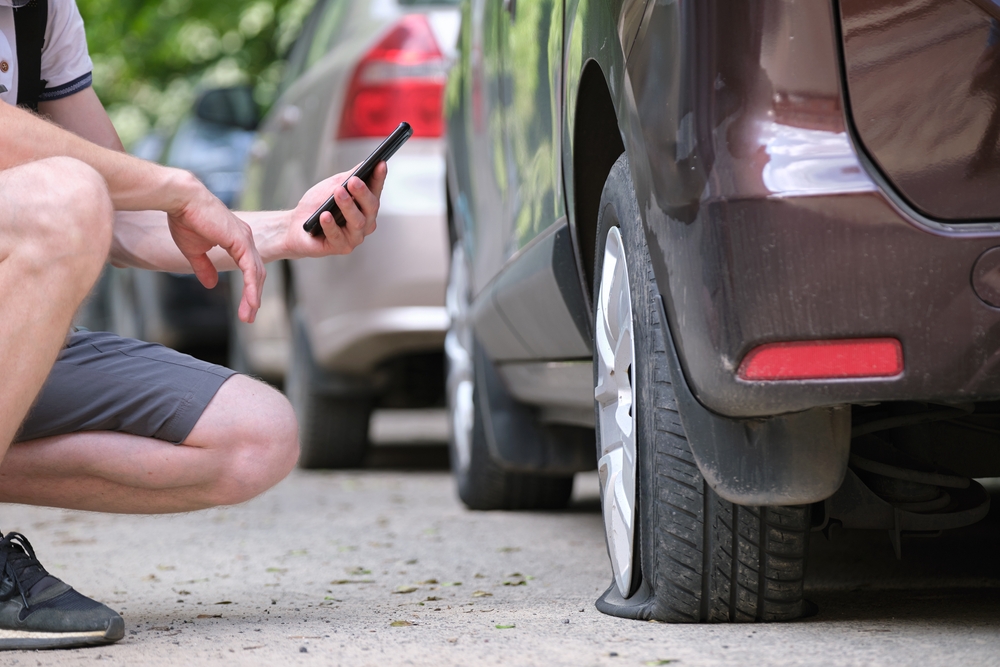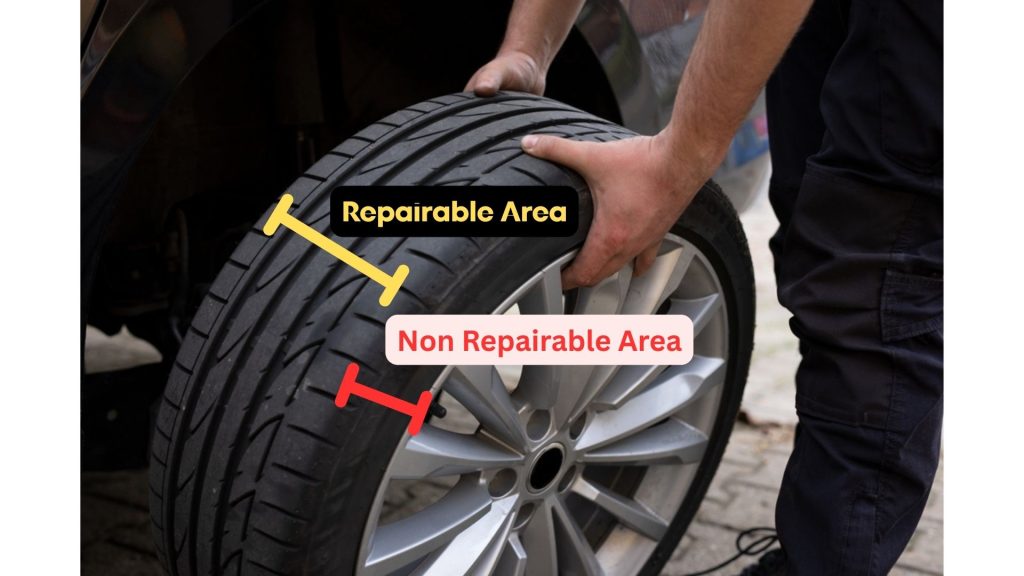Which Punctures Can be Managed Via On-Road Tyre Repair?

Experienced one of those days where you’re just trying to get from A to B and boom! Your car starts feeling wobbly?
You hop out, and yup! your tyre’s flatter than a pancake on Sunday morning.
Punctures happen to the best of us. One nail, one piece of glass, one rogue pothole. And you’re stuck on the side of the road Googling tyre repairs near me. That sometimes is not anywhere nearby.
Then what to do? Don’t worry, we are just about to guide you on that.
We’re your local go-to crew for everything from quick tyre repair to full vehicle servicing. So, if you don’t know how to determine a tyre puncture as fixable or how to fix it temporarily on spot. Buckle up. Morley Tyre Centre has got your answers.
Got a Flat? Here’s When a Tyre Can Be Repaired (And When It Can’t)
The fixability of a puncture depends upon the area of tyre. Here are some common spots where you can find a puncture.
1. Puncture in the Tread Area – The Sweet Spot
The centre of your tyre, the part that actually touches the road, is called the tread area.
If a sharp object pokes a hole in this zone, you’re in luck. As long as the hole is less than 6mm wide and hasn’t been driven on while flat. A proper tyre puncture repair is possible.
It’s like the tyre’s version of a minor injury. You can patch it up and get back on the road without missing a beat.
2. Puncture in the Shoulder Area – Risky Business
The shoulder is the bit between the tread and the sidewall.
This area tends to flex a lot when driving, especially on turns. A puncture here puts the tyre at serious risk of blowing out, which is a big no-no. Even if a plug or patch seems to hold, the movement in this area makes repairs unreliable.
So, if the damage is in the shoulder, replacing the tyre is the safest call.
3. Puncture in the Sidewall – Game Over
If your car tyre puncture repair concern involves the sidewall. It’s time to start shopping for a new tyre.
Sidewalls aren’t just rubber. They’re packed with structural cords that help your tyre hold its shape under pressure. Once those cords are damaged or pierced, no amount of flat tyre repair kits or plugs can truly fix the issue.
Repairs here would compromise the integrity and safety of the tyre.

Other Things That Affect Whether a Tyre Puncture Can Be Repaired
Sometimes, it’s not just about where the puncture is. It’s also about how the tyre has reacted to the damage.
Here are a few other things we check before calling it a repairable case.
1. Tyre Mottling (Weird Wear Patterns)
Ever seen strange dots, discolouration, or wear spots on your tyre? That’s mottling.
This usually points to internal breakdown or misalignment issues. If your tyre has weird patterns and a puncture on top of that. It’s not worth trying to save it. Even if you plug the hole, the underlying issue can make the tyre unsafe.
2. Tyre Dislocation or Bead Damage
If your tyre has shifted off its rim or suffered bead damage from running flat for too long. It won’t hold air properly, even after a repair.
In such cases, you should better off replacing the whole tyre.
3. Cracks or Separation of the Inner Liner
The inner liner is the part of the tyre that keeps air sealed in.
If it gets cracked or separated (especially from driving on a flat tyre for too long), the tyre is toast. No plug or patch will safely seal that kind of damage.
4. Puncture Size & Angle
A straight-down puncture is usually repairable. But if the object went in at an angle, or the hole is over 6mm wide, the repair won’t hold up well under road pressure.
Long gashes or side-entry punctures cause hidden internal damage. Even if they look small from the outside.
5. Type of Tyre (Run-Flats, Low-Profile, etc.)
Some tyres come with manufacturer guidelines that prohibit repairs, especially run-flats.
These tyres are designed to drive short distances after going flat. But if they’re punctured, many brands recommend full replacement. Always check the sidewall markings or ask a pro to save your time & effort (money too).
Now that you know the fixable puncture cases. It’s time to teach you how to do it. Especially for the time when you can’t find the tire repair shop nearby.
How to Use a Tyre Puncture Repair Kit (The Right Way)
Alright, you’re in a jam and you’ve got a flat tyre repair kit in the boot. Here’s how to use it correctly:
Step 1: Find the Leak
Roll the tyre or pour a bit of soapy water on it to spot bubbles. That’s where the air is leaking.
Step 2: Remove the Object
Use pliers to pull out the nail or shard. Be careful, it can still have air pressure.
Step 3: Clean the Hole
Use the rasp tool to widen and clean the hole for a better plug grip.
Step 4: Insert the Plug
Stick the rubber plug halfway into the insertion tool. Coat it with rubber cement (if available) and jam it into the hole until about 1cm is left outside.
Step 5: Trim and Inflate
Cut off the excess plug, reinflate the tyre, and check if it holds pressure.

Remember that kit is useful for emergencies, but it’s not a long-term fix. So, even if you’ve managed your puncture yourself. It is recommended to drive to a tyre repair shop near me ASAP for a professional patch from the inside.
And if you find the quick fixes are not working. The tyre is losing air again after repair or rolling weirdly. It is better to just use a spare for your safety.
When to Just Use the Spare Tyre?
If the puncture is in a sketchy spot, you can’t find the leak, or the repair process isn’t working. These are the signs that it’s either impossible, impractical or dangerous to repair a tyre.
So, search for a tire and repair shop nearby. And slap on spare to drive you there.
But remember, spares aren’t built for long-distance or high-speed driving. Drive safely & get to a professional service as soon as you can.
Why Trust a Professional for Tyre Repairs?
We get it, DIY feels heroic. But there’s a reason professionals like us exist. Not one but many, e.g.
- We Check Internals: We inspect the inside of the tyre using professional tools to spot internal separations or bead damage.
- Better Tools, Better Seals: Our plugs and patches are superior to what’s in your glovebox kit.
- Experience Counts: Even if you take the most advanced tools wit you. There’s a huge difference between novice & experienced hands.
- Compliance with Safety Standards: We follow Australian safety standards for tyre puncture repair. So, you’re not risking a blowout at 100km/h on the freeway.
Searching for “Tyre Puncture Repair Near Me”?
Trust Morley Tyre Centre for Puncture Repair & More
At Morley Tyre Centre, we don’t just patch tyres, we give you peace of mind.
From tyre fitting and flat tyre repair to full brake checks and log book servicing. We’ve got the tools, skills, and car love to keep you rolling safe and smooth.
Stop by today or book online for expert tyre repair and more.
Schedule Your Tyre Repair Service Now
Explore Our Car & SUV Tyre Range
FAQs
Q1. How do I know if a tyre puncture is repairable?
Check if the hole is in the tread, under 6mm, and not angled. Still unsure? Get it checked professionally.
Q2. Can a DIY tyre repair kit fix all flats?
Nope. It’s for minor tread punctures only. Always follow up with a proper repair.
Q3. What if the puncture keeps leaking air?
It could be an internal issue. Don’t risk it, put a spare on and get a pro to look inside.
Q4. Is it safe to drive on a plugged tyre?
Short term, yes. But long-term safety needs a proper patch from the inside.
Q5. How much does a tyre repair cost in Australia?
Prices vary, usually between $30–$50. But don’t worry, they’re way cheaper than a new tyre.
Q6. Where can I get flat tyre repair near me?
If you’re in Morley, Noranda, Dianella, Bayswater, Bedford, Bassendean or nearby. Morley Tyre Centre is your best bet.
